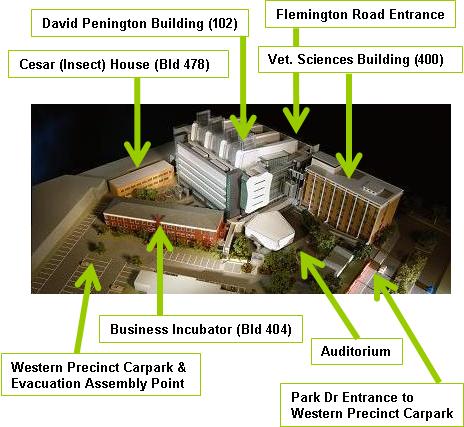General Building Matters
General building matters
The Bio21 Institute facility (including the Insect House and Incubator building 404) is maintained by the University's Property and Campus Services, including cleaning, security, general building and electrical maintenance. A Building Services Engineer supervises these aspects of the facility and is located in the Gatehouse on the Western Precinct carpark at the Bio21 Institute.
Security
Key access points in the Bio21 Institute are monitored by security cameras and security personnel regularly patrol the Institute.
Location
Security personnel are located in the Institute 24 hours a day, 7 days per week. The Security Office is located in Room G45, Ground Floor North, in the Atrium opposite the NMR viewing area.
For assistance
If you require assistance, please contact the Institute's security office on ext 42480 or 42481, or the University's 24 hour, 7 days per week security station on ext 46666.
Working late
If you are working late and would like a officer to escort you to your car, please contact security to arrange a convenient time. Also refer to procedures for after hours work in the Institute.
First Aid
All security personnel are trained in first aid procedures should a suitably trained person not be at hand in your area.
Maintenance requests
You should report general maintenance issues through the Institute's Buildings Maintenance Report System (BMR). See the Frequently Asked Questions section of the BMR if you need help to determine the suitability of the system for your purpose.
The BMR should not be used in the case of emergency (e.g. fire, triggered alarms etc.), security, keys, access cards, parking, mail, department-owned furniture, lab equipment, computing problems, and minor work projects.
Requests for maintenance cannot be made directly with the University's Maintenance office.
Any immediate concerns with services or building issues should be directed to the Institute's Building Service Engineer, who will liaise with the appropriate people.
The Institutes facilities are complex and have extensive cabling and wiring. For your own safety and to ensure there is no damage to services, all requests, including hanging picture hooks, should be entered through the BMR.
Cleaning
The Institute is cleaned after hours for the following work day by external contractors. This includes toilets, emptying of general waste bins and recycling bins within offices and floors.
Any cleaning issues or requests should be entered through the BMR. See the Frequently Asked Questions section of the BMR if you need help to determine the suitability of the system for your purpose.
Electrical powerpoints
Electrical powerpoints are colour coded according to their use as follows:
- White and grey points are for normal use items such as computers and photocopiers.
- Red points are for appliances that need to be connected to emergency generators such as fridges and freezers.
- Blue points are for cleaner's use.
Three phase power outets are located in the Atrium, Ground Floor South (outside the doors to the lab and office area) and Ground Floor North (inside doors leading to the Stores and to left).
All electrical appliances must be tested and tagged. This includes all personal electrical items and external appliances, power boards and urns, etc.. For more information see Section 11.7 of Managing Operational Risk in the University's EHS Manual (New). Queries can be directed to the Institute's EHS Manager.
Lighting
Lights in laboratories switch off in two stages. The first row of lights will go off at 8pm and the second at 8.10pm. If there are people still in the lab when the lights go off, simply reset for a further two hours. Lights in fume cupboard areas will switch off at 10pm. Lights in offices and hallways will switch off at 8pm. Again, simply reset for a further two hours when the first set of lights switch off. See the Institute Lighting Scheme for more details.
Light switches throughout the building are a spring loaded mechanism. They do not stay in the on or off position as per normal household switches. They are to be "flicked" on or off (the switch returns to the upright position).
Security will provide escorts to vehicles in the above ground carpark if requested.
Airconditioning
The Institute is in a controlled air conditioned facility. Some offices have an electronic air conditioning controller which enables the occupant to change the temperature in the office. Air conditioning to office areas ceases at 8.00pm and recommences at 7.30 am. Enquiries regarding the air conditioning system should be directed to the Building Services Engineer who will assist with your query or liaise with the appropriate service people.
Lifts
There are three passenger lifts located in the centre of the complex in the Atrium accessing basement to level 5. A passenger lift is also located on the western side of the building opposite reception accessing Mezzanine to Basement. A goods lift is located on the eastern side of the north building accessing the basement and all levels.
To access lifts from the basement/carpark, you will need to swipe your access card over the reader.
Doors
Doors with access card readers throughout the building may be alarmed. Please check with Security before leaving doors ajar or wedged open in order to avoid unnecessary triggering of alarms.
Emergency Stairs
Commuting between floors in the building is by passenger lifts and stairwells. Emergency stairs are indicated on evacuation plans located on each floor. Emergency stairs should be kept clear and their doors closed for use in an emergency.
Removal of items or equipment from the Institute
The University's security personnel have instructions to check anyone seen removing items from the Institute or campus.
If it is absolutely essential that University/Institute equipment be taken off campus for any reason, the request must firstly be made with the Institute's Scientific Research Manager (through the SRM's PA), who will issue an authorization and secondly, where required, arrange insurance coverage for the item/equipment.


